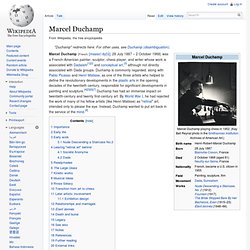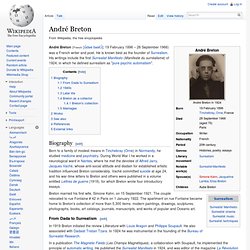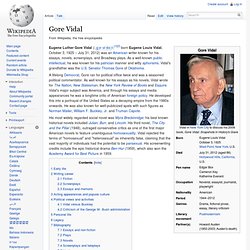

Marcel Duchamp. Marcel Duchamp (French: [maʁsɛl dyʃɑ̃]; 28 July 1887 – 2 October 1968) was a French-American painter, sculptor, chess player, and writer whose work is associated with Dadaism[1][2] and conceptual art,[3] although not directly associated with Dada groups.

Duchamp is commonly regarded, along with Pablo Picasso and Henri Matisse, as one of the three artists who helped to define the revolutionary developments in the plastic arts in the opening decades of the twentieth century, responsible for significant developments in painting and sculpture.[4][5][6][7] Duchamp has had an immense impact on twentieth-century and twenty first-century art. By World War I, he had rejected the work of many of his fellow artists (like Henri Matisse) as "retinal" art, intended only to please the eye. Instead, Duchamp wanted to put art back in the service of the mind.[8] Importance[edit] Early life[edit] Of Eugene and Lucie Duchamp's seven children, one died as an infant and four became successful artists. André Breton. André Breton (French: [ɑ̃dʁe bʁətɔ̃]; 19 February 1896 – 28 September 1966) was a French writer and poet.

He is known best as the founder of Surrealism. His writings include the first Surrealist Manifesto (Manifeste du surréalisme) of 1924, in which he defined surrealism as "pure psychic automatism". Biography[edit] Born to a family of modest means in Tinchebray (Orne) in Normandy, he studied medicine and psychiatry. During World War I he worked in a neurological ward in Nantes, where he met the devotee of Alfred Jarry, Jacques Vaché, whose anti-social attitude and disdain for established artistic tradition influenced Breton considerably. Breton married his first wife, Simone Kahn, on 15 September 1921. From Dada to Surrealism[edit] In 1919 Breton initiated the review Littérature with Louis Aragon and Philippe Soupault.
In a publication The Magnetic Fields (Les Champs Magnétiques), a collaboration with Soupault, he implemented the principle of automatic writing. Anaïs Nin. Anaïs Nin (Spanish: [anaˈis ˈnin]; born Angela Anaïs Juana Antolina Rosa Edelmira Nin y Culmell, February 21, 1903 – January 14, 1977) was an author born to Spanish-Cuban parents in France, where she was also raised.

She spent some time in Spain and Cuba but lived most of her life in the United States where she became an established author. She published journals (which span more than 60 years, beginning when she was 11 years old and ending shortly before her death), novels, critical studies, essays, short stories, and erotica. A great deal of her work, including Delta of Venus and Little Birds, was published posthumously. Early life[edit] Anaïs Nin was born in Neuilly, France, to artistic parents. On March 3, 1923, in Havana, Cuba, Nin married her first husband, Hugh Parker Guiler (1898–1985), a banker and artist, later known as "Ian Hugo" when he became a maker of experimental films in the late 1940s. Personal life[edit] Nin often cited authors Djuna Barnes and D. Literary career[edit] Gore Vidal. Early life[edit] Vidal's father served as director of the Commerce Department's Bureau of Air Commerce (1933–1937) in the Roosevelt administration,[9] was one of the first Army Air Corps pilots and, according to biographer Susan Butler, was the great love of Amelia Earhart's life.[10] In the 1920s and 1930s, he was a co-founder of three American airlines: the Ludington Line, which merged with others and became Eastern Airlines, Transcontinental Air Transport (TAT), which became TWA), and Northeast Airlines, which he founded with Earhart, as well as the Boston and Maine Railroad.

The elder Vidal had also been a West Point football quarterback, coach, and captain and an all-American basketball player. He also participated in the 1920 and 1924 Summer Olympics (seventh in the decathlon; U.S. pentathlon team coach).[11][12] Writing career[edit] Maya Deren.